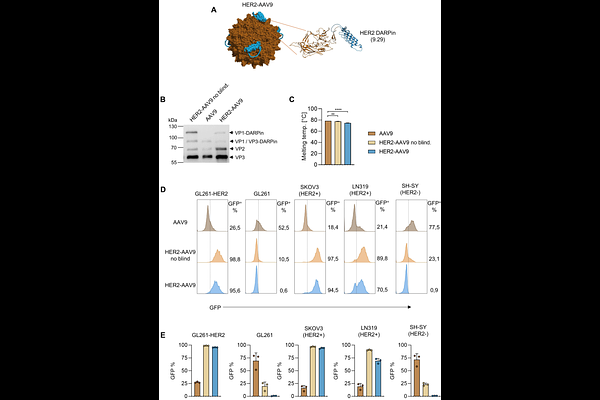Engineered AAV9 as in vivo gene delivery platform for the selective transduction of TME cell subsets

Engineered AAV9 as in vivo gene delivery platform for the selective transduction of TME cell subsets
Demircan, M. B.; Strassheimer, F.; Zinser, L. J.; Elleringmann, P.; John, F.; Thalheimer, F. B.; Steinbach, J. P.; Oellerich, T.; Burger, M. C.; Buchholz, C. J.
AbstractPrecise in vivo gene delivery to specific cell types remains a significant challenge in gene therapy, particularly for cancer immunotherapy applications. Here, we rationally engineered AAV9 to become a modular, receptor-targeted vector for selective in vivo gene delivery. We first identified the N272A and W503A mutations as effective in ablating the native tropism of AAV9. Subsequently, designed ankyrin repeat proteins (DARPins) were inserted into the GH2/3 capsid loop, redirecting vector specificity towards defined cellular receptors without compromising capsid integrity or yield. As a proof of concept, HER2-targeted DART-AAV9 vectors demonstrated highly selective transduction of HER2-positive tumor cells in vitro and in vivo, in both, subcutaneous and orthotopic glioblastoma models, with negligible transduction of off-target organs including liver, heart, and kidney. When equipped with immunomodulatory genes (anti-PD-1 or IL-2) HER2-DART-AAV9 mediated secretion of functional therapeutic proteins from transduced tumor cells. Additionally, our modular platform facilitated rapid generation of CD8-targeted DART-AAV9 vectors, enabling selective transduction of human CD8+ T cells. Importantly, the engineered vectors exhibited favorable resistance to neutralization by human serum and retained their specificity and potency in human blood, underscoring their potential for clinical translation. Together, these findings establish DART-AAV9 as a versatile, precise, and clinically promising gene delivery platform for cancer immunotherapy.